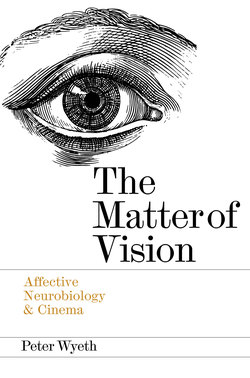Читать книгу The Matter of Vision - Peter Wyeth - Страница 15
На сайте Литреса книга снята с продажи.
Kuleshov & Gazzaniga
ОглавлениеAn example of the Affective Neurobiology approach to Cinema can be seen in links between two moments, the Kuleshov34 experiments of 1917, which featured a famous actor with a neutral expression intercut with emotive shots – a crying baby, an attractive woman, a hot bowl of soup, and a famous experiment by the neuroscientist Gazzaniga around fifty years later. What interests me about Kuleshov is not the discovery of editing per se, for which it is best-known, but the idea that the audience filled-in the neutral expression of the actor according to what was in the succeeding shot – for soup he was said to look hungry, for a crying baby sympathetic etc.
Gazzaniga35 worked with a split-brain patient who was presented with three objects – a chicken foot, a spade and a shed. The patient had no problem – the spade was for shovelling the chicken-poo out of the chicken shed.36 I would suggest a rather similar process is going on in both cases, which is that the brain constantly seeks to rationalise the slim resources of Consciousness by linking stimuli in a meaningful way. Another way of seeing that impulse is towards narrative, a narrativising process. There are several other examples in the way the brain functions that show a related activity. That suggests there is a biological basis to narrative and suggests one reason why narrative Cinema has been the dominant mode of the medium.
The view of this project is that not only do we have very little idea of what we learn from Cinema, but little idea of how the brain responds to it. Neuroscience rooted in the historical sense of Evolution combined with an emphasis upon Emotion offers the possibility of overcoming those deficits and in the process adding to our stock of scientific knowledge of the brain. Compared to the analyses offered by Film Theory that would seem to be a rather more worthwhile project.
